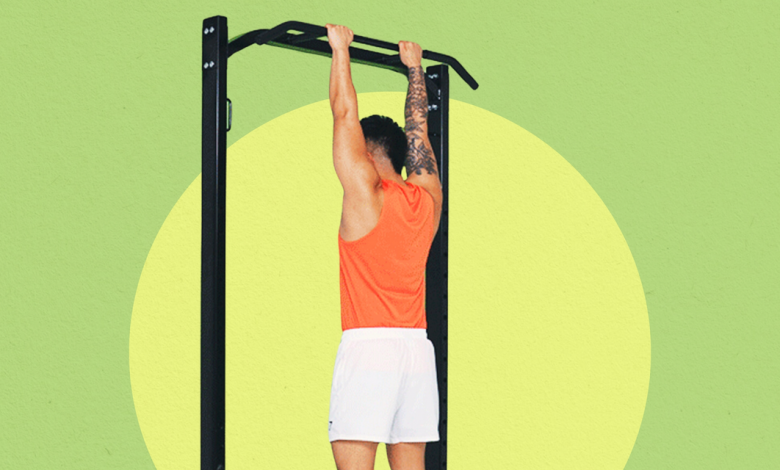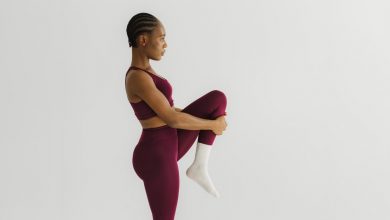Why Hanging From a Bar for 10 Seconds Is a Great Way to Start a Workout

After a long day hunched over my laptop, my body sometimes feels like a crumpled up ball of paper ready to be thrown in the trash. Just standing straight again can be a real, um, stretch. But I’ve discovered a shortcut to opening back up my back and shoulders: the dead hang exercise.
This move is pretty much what it sounds like. You just hold onto a horizontal bar above you with your arms straight, like the bottom of a pull-up position. Doing this harnesses the power of gravity to help decompress your spine, Richard Sanchez, NASM-CPT, a personal trainer for Crunch Fitness in New York City, tells SELF. “For people who sit for long periods of time, it’s a great thing to start learning.”
This might sound simple enough—kids do it on the playground all the time, right? Well, it turns out you actually should be a little more strategic with your technique to get what you want out of this move, California-based physical therapist Jacob Van Den Meerendonk, DPT, tells SELF. “It’s not just ‘Go up there and hold onto the bar and assume that this is going to be a healthy exercise.’ We need to be mindful of what our goals are.” That’s because changing up which muscles are actively engaging to keep you steady on the bar can redirect where exactly you feel that sweet release.
Don’t worry, we won’t keep you hanging—read on below for all the intel you need to know before you start.
Dead hangs not only loosen up your back and shoulders, they’re also a great way to improve your grip strength.
Like me, the first thing you might notice when you’re doing a dead hang is how amazing it feels on your spine. After letting go, you might even notice you’re standing a little taller. “You can get somewhat of a decompression in the lumbar spine,” Dr. Van Den Meerendonk says, which can help ease that feeling of tightness. That’s because in a dead hang, your lower body is pulling your weight down away from the bar, creating some traction to open up the little segments within your spine.
For similar reasons, Dr. Van Den Meerendonk often uses the dead hang exercise in his clinic to work on shoulder mobility. Hanging from a bar with your arms overhead can increase space in the joint, which is just generally good for your shoulder health, but can also be particularly useful for conditions like shoulder impingement, in which the bones (and other good stuff, like your tendons) are jamming together.
Then there are the performance benefits too. Many gymgoers also perform dead hangs to work on their grip strength. “It’s honestly one of the simplest, most effective ways” to build it, Sanchez says. Beefing up those tiny muscles in your hands, wrists, and forearms can pay off in both the weight room (since you’ll be better able to maintain your grasp on heavy free weights, say, like when you’re deadlifting) and daily life (like when you’re trying to pry open that jar of pasta sauce).
And if you’re working on your pull-ups, Sanchez says these are a great way to practice. Just by hanging out in an isometric (a.k.a. stationary) hold, you’ll strengthen the muscles in your shoulders, back and core, and all the way down your arms to your fingers—exactly what you’ll need to finally pull off your very first pull-up.
But not all dead hangs are created equal.
As straightforward as this move may seem, there are actually a few different ways to approach it—which can potentially change what you get out of the exercise.
You don’t have to jump up to grab the bar.
For beginners, Dr. Van Den Meerendonk suggests using a bar at a height that’s easy to grab onto. Maybe it’s lower down (say, set up on an adjustable Smith machine) or maybe you’re standing on a step to more easily reach a pull-up station. Either way, “when you’re reaching up, you’re already reaching the bar,” he says.
From there you can just bend your knees to get into the dead hang, keeping your toes on the floor to support some of your weight. This will give you control over how much stress you’re putting through your shoulders. Alternatively, Sanchez says you can loop a long resistance band around the pull-up bar, then step into it for a banded hang so it takes some of your weight. Once you’re comfortable with one of these versions, then you can work on jumping up to catch the bar above you.
Letting go of tension in your shoulders will increase the stretch in that joint.
If you’re mostly looking to loosen up your shoulders in your dead hang, Dr. Van Den Meerendonk recommends this modification: Once you’re in the position, slowly release the muscles in your shoulder girdle to sink down lower and increase the traction in the joint. “As you relax the shoulder muscles, you’ll notice your head—and entire body— dropping down,” he says, adding that you’ll feel a stretch in the joint as you do so. “Little by little does the trick.” Just remember to keep your core tight to support you—and maintain your tight grip on the bar.
Or let your core relax a bit for a lower back release.
Alternatively, if you’re doing a dead hang to loosen up your lower back, you’ll want to try to relax your core. While holding tight onto the bar with your hands and keeping your shoulders engaged, play with letting your core muscles start to let go. “That allows for your legs to drop further and for your low back to traction,” Dr. Van Den Meerendonk says.
For long-term benefits, make dead hangs a regular part of your warm-up.
A dead hang is gentle enough on your body that you can do it every day. It can be especially effective as part of a warm-up to open up and engage your upper-body muscles, switching on that all-important mind-body connection before moving on to more intense strength training. “When you have to hold your body weight up, you become much more aware of what muscles are being engaged, “ Sanchez says. “So it’s a good way to train how the back should be feeling in the correct position.” He recommends starting with two or three 10-to-15-second holds, and working your way up to 45 to 60 seconds at a time.
Once you’re up there, Sanchez suggests focusing on belly breathing by inhaling slowly through the nose and out through the mouth. And unless you’re strategically letting your core go to work on lower back mobility, you’ll want to keep it activated. “If your core is not engaging, it’s hard for the rest of the body to activate in a proper way,” Sanchez says.
Some people feel some strain in their neck in this position; Sanchez says you can avoid that by keeping your chin tucked in. But if at any point you feel pain, stop hanging. “The exercise itself should be promoting shoulder mobility and stability and not making it worse,” he says.
Really, you’re better off not trying a dead hang at all if you’re dealing with acute shoulder or back conditions—Dr. Van Den Meerendonk warns this isn’t a treatment you should try as a DIY fix at home. “You can really injure yourself,” he warns. See a physical therapist first; they’ll not only know if it could help your pain or not, but they’ll tel you how you can get the most out of it for your body.
Here’s how to do an active dead hang the right way.
Katie Thompson
- Reach for the bar with your palms facing forward, just wider than shoulder-width apart.
- If your feet are on the ground while you’re holding onto the bar, simply “unweight your knees” or bend your legs so that it’s your hands on the bar holding you up rather than your feet on the floor. Otherwise, jump up to grab on.
- To start, keep your shoulder girdle and your core tight to support your weight.
- If you’re working on shoulder mobility, try relaxing the tension in the shoulders. Or if you’re looking for a lower back release, play with relaxing your core muscles.
- Try to hold the position for 10 to 60 seconds or until you start to feel any strain. Aim for two or three reps.
Related:
- How to Do the Kettlebell Windmill to Light Up Your Abs and Shoulders
- The 24 Best Stretching Exercises for Better Flexibility
- 16 Hip Stretches Your Body Really Needs
Get more of SELF’s great fitness coverage delivered right to your inbox—for free.



